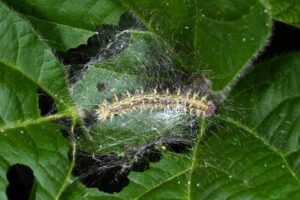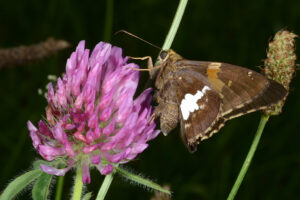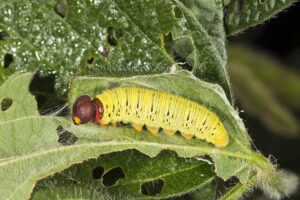This is a wonderful time of the year in the Hoosier state, as we drive through the countryside, we are greeted with the pleasing sight of several colorful butterfly species gliding across and roads, near puddles of water, or on fall flowering plants. Many of these beauties originated from larvae that likely fed on soybean or alfalfa. However, it is rare for any of these species to cause significant yield losses from defoliation. Below is a listing, with pictures, of some of the common butterflies and their caterpillars this time of year. Although you will find some of these feeding in crops, none are pests.
The painted lady butterfly, Vanessa cardui, is mostly orange mottled with black and white markings. This is a migratory species flying from and to Mexico and the Southwestern United States in the spring and fall. Adults arrive in Indiana in the spring and lay their eggs on several species of plants. Although they feed on many weed species, their preferred host is Canada thistle. Several generations occur in Indiana before they begin their migration southwestward in the fall. The larvae, known as thistle caterpillars, are generally dark in color, with conspicuous yellowish markings on their bodies. The larvae are covered with many branching spines. Larvae reach a length of about 1-1/4 inches. The larvae feed within webbed enclosures on the upper leaves and may defoliate entire patches of weeds and feed in a similar manner on soybean – you may have seen a few leaves webbed together to form a “tent”, and you will find the spiky caterpillars inside.
The yellow alfalfa butterfly, Colias eurytheme, is a member of the “sulfurs.” These butterflies congregate in large numbers near sources of moisture, including puddles and wheel ruts. They are most active during mid-day, their peak mating time. The larvae of these butterflies are the alfalfa caterpillar. This caterpillar is up to 1-1/2 inches long, has a velvety-smooth lime-green body with a white stripe on each of its sides. This caterpillar is common in legumes like alfalfa, clover, and vetch, but it can be occasionally found defoliating soybean leaves. Though the numbers of butterflies may be numerous, this does not indicate an outbreak of caterpillars is soon to follow. These caterpillars are very susceptible to insect diseases that can rapidly bring their numbers down to very low levels.
The creepiest-looking caterpillar award goes to the silver-spotted skipper, Epargyreus clarus. These larvae are up to 2 inches in length, have brownish-red heads with two orange spots and a yellowish-green body. This is a common subject of the “what the heck is this bug” emails and text messages we receive. Larvae can often be found in leaves that have been rolled together and held by the caterpillars’ silken threads. Feeding damage is generally localized to a few surrounding plants. Adult skippers, which are commonly seen feeding on flowers late in the summer, have an obvious silver-white splotch on each wing.








